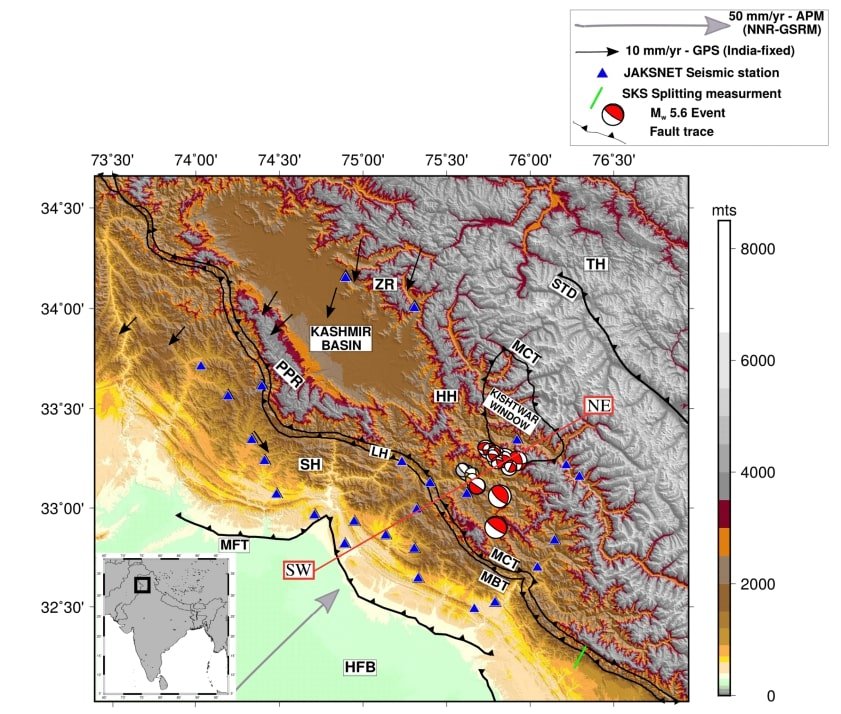Seismic Anisotropic Study of the Northwest Himalaya from splitting measurements of SKS and direct S phases
DAAD-Fellowship
The study of seismic anisotropy provides a first-order understanding of either active or fossil deformation of the crust and the upper mantle. Shear waves traveling through anisotropic media split into two quasi shear waves - the component polarized parallel to the fast direction exhibits a higher velocity than its orthogonal component. Seismic anisotropy of the lithosphere is constrained using two parameters - [a] the azimuth of the polarization direction of the fast wave (FPD) and [b] the time delay between the fast and slow wave.
The tectonically active Himalayan orogen is among the best natural laboratories to investigate the ongoing continent-continent collisional processes, and to develop insights into its geodynamic evolution. There are a limited number of previous anisotropic studies carried out in our region of interest of the northwest Himalaya. Recent enhancement in broadband instrumentation provides an unprecedented dataset to study this process. Thus, a seismic anisotropic study based on the much better data availability is a logical step in order to resolve the ongoing geodynamics of the northwest Himalaya. Specifically, we propose to determine azimuthal seismic anisotropy using core refracted shear waves (SKS) and direct S waves. This study will use data from the regional seismological network in the northwest Himalaya, namely Jammu and Kashmir Seismological Network (JAKSNET), that has been operational since July 2013. Time Series data from 29 broadband, three-component seismograph stations will be used for the analysis. The seismometers have been installed under joint collaborative efforts between Indian Institute of Science Education and Research (IISER) Kolkata, Shri Mata Vaishno Devi University and University of Cambridge, UK. The network extends across the Himalayan arc from the Siwalik (S), Lesser, Greater, and the Tethyan Himalaya (N), and along the arc from Jammu-Kishtwar (E) to the Kashmir Valley (W). Two different datasets are to be used for SKS (with epicentral distance 85°-135°, Mw>5.5) and direct S wave measurements (with epicentral distance 40°-80°, Mw>5.5). Expected outcomes from the project are -
1. Individual station measurements of splitting parameters help to ascertain the lateral variation of anisotropy and compute the station average regional degree of anisotropy in northwest Himalaya.
2. Mapping of the mantle flow field using the FPD as its proxy and reveal the main source of anisotropy (i.e., whether it predominantly resides in the lithosphere or shallow asthenosphere) by correlating anisotropic parameters with geodetic and long-term geologic measurements.
3. Constraining the orientation and the degree of anisotropy of the shear induced anisotropic foliation planes on the Main Himalayan Thrust.
4. To ascertain whether the splitting parameters obtained indicate a two-layer of anisotropyby correlating the fast axes azimuths and delay times with the source polarization direction. Comparison of our results with splitting measurements from the Indian shield will distinguish between pre-collisional ‘frozen anisotropy’ and present day deformation generated anisotropic features in the underthrusting Indian crust beneath northwest Himalaya.

Time frame
- 2023 - 2024
Principal Investigator
- Rupak Banerjee (Fellowship)
Host
- Prof Frederik Tilmann (GFZ)
- Prof Supriyo Mitra (Indian Institute of Science Education and Research (IISER) Kolkata)
Funding
- Research Grants - Bi-nationally Supervised Doctoral Degrees/Cotutelle, 2022/23 (57588368) sponsored by the German Academic Exchange Service (DAAD)
Partner
- University of Cambridge, Cambridge (Prof Keith Priestley)
- School of Physics, Shri Mata Vaishno Devi University, Katra, India (Dr Sunil Wanchoo)
Research Unit(s) (POF/GIPP/MESI)



